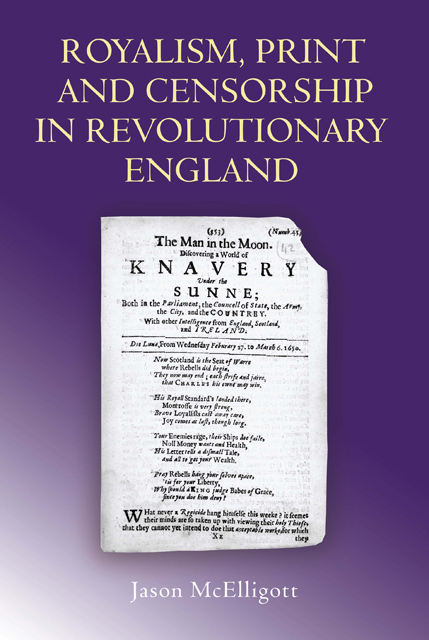Book contents
- Frontmatter
- Contents
- Illustrations
- Acknowledgements
- Abbreviations
- Introduction: Royalism and its Problems
- 1 Royalists and Polemic in the 1640s
- 2 The Politics of Sexual Libel
- 3 The Twists and Turns of Royalist Propaganda
- 4 Authors, Shifting Allegiances and the Nature of Royalism
- 5 Printers, Publishers and the Royalist Underground
- 6 Hunting the Royalist Press
- 7 The Theory and Practice of Censorship
- 8 A New Model of Press Censorship
- Conclusion
- Select Bibliography
- Index
6 - Hunting the Royalist Press
Published online by Cambridge University Press: 10 March 2023
- Frontmatter
- Contents
- Illustrations
- Acknowledgements
- Abbreviations
- Introduction: Royalism and its Problems
- 1 Royalists and Polemic in the 1640s
- 2 The Politics of Sexual Libel
- 3 The Twists and Turns of Royalist Propaganda
- 4 Authors, Shifting Allegiances and the Nature of Royalism
- 5 Printers, Publishers and the Royalist Underground
- 6 Hunting the Royalist Press
- 7 The Theory and Practice of Censorship
- 8 A New Model of Press Censorship
- Conclusion
- Select Bibliography
- Index
Summary
This chapter will examine in detail the efforts of the authorities to detect and suppress the underground royalist newsbooks. Historians have been struck by the general state of disorder in London and throughout England during the late 1640s, and have accordingly taken a dim view of the ability of the authorities to impose their will upon the press during these years. Joseph Frank wrote that censorship had ‘completely broken down by late 1647’, and Joad Raymond claims that the central authorities were ‘complacent’ about the dangers of the royalist press and that the Stationers’ Company, the traditional first line of defence against unlicensed printing, ‘disintegrated during the 1640s’. Such comments echo the great Samuel Gardiner's claim in his History of the Commonwealth and Protectorate that ‘unlicensed presses easily kept themselves in existence’ in the wake of the Printing Act of September 1649.
The central contention of this chapter, by way of contrast, is that even during these chaotic years there was no complete breakdown of censorship. The authorities possessed a variety of mechanisms which, when properly deployed and supervised, were able to tame the press. Although the individual searchers, or ‘bloodhounds’ as the royalists called them, unleashed by the regime arrested many individual authors, printers, booksellers and hawkers, they were initially unable to inflict any serious damage on the network or networks that sustained and produced the royalist newsbooks. There were several reasons for this failure: the unprecedented volume and variety of unlicensed and seditious material spewing from the presses during these years made any attempts at regulation extremely difficult; the searchers may sometimes have been hindered by the difficulties of co-ordinating the activities of the various individuals and organizations charged with regulating the press; and one should not underestimate the commitment, determination and courage of the men and women involved with the royalist newsbooks, or the effectiveness of the measures that they took to ensure their security.
- Type
- Chapter
- Information
- Royalism, Print and Censorship in Revolutionary England , pp. 150 - 182Publisher: Boydell & BrewerPrint publication year: 2007

